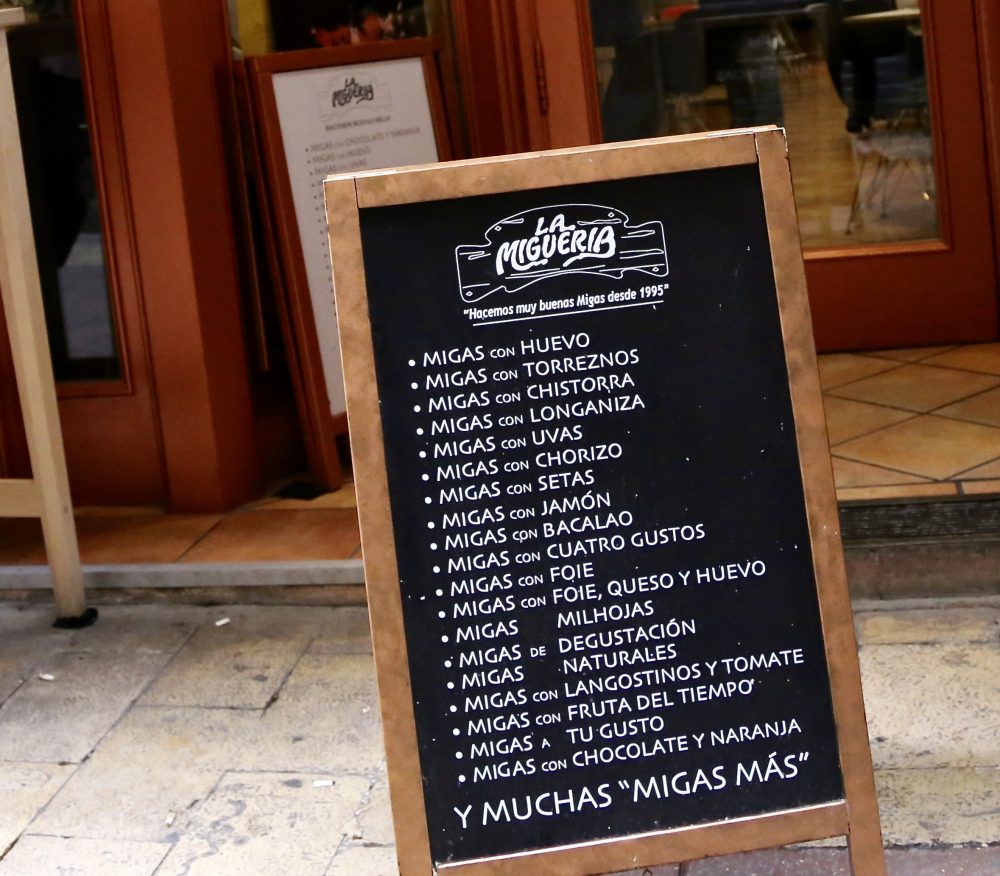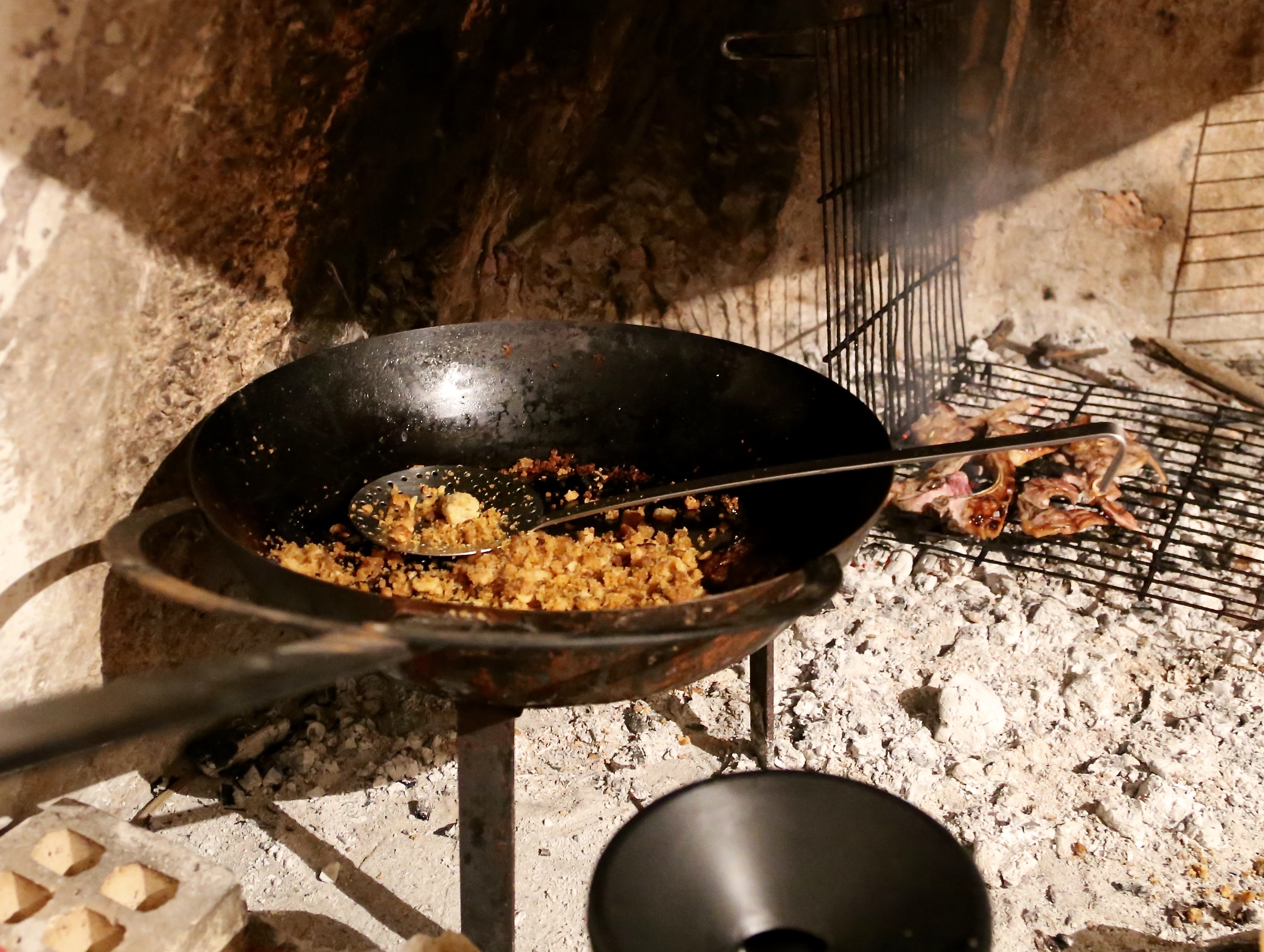Four leather-clad bikers and I walk into a bar in northeastern Spain. We've come for the crumbs.
It's a late lunch at La Casa de las Migas in “El Tubo,” the tapas crawl district of Zaragoza. The menu is heavy on the migas, the breadcrumb-based something-from-nothing for which the region is known. The description doesn't do it justice.
The five of us—together only by chance—order the specialty. The waiter dashes into the tiny kitchen to see if the cook will oblige—it's nearly 4 p.m., late for the midday meal even by Spanish standards—and returns all smiles.
Born out of use-it-up sensibility, migas began as stale breadcrumbs that are sprinkled with water, then fried with garlic and flecks of sausage before being topped with just about anything, though eggs often appear in some form. Variations are popular across Spain and Portugal, and even have made their way to the new world; in Mexico there's a tortilla-based version.
Founded in 1900, La Casa de las Migas (House of Crumbs) has just eight wooden tables with a larger beer garden adjacent, furnished with barrels. Behind the bar, a row of hams hang next to rows of bottles.
I've asked for the most traditional version of migas, which turns out to be topped either with a fried egg or grapes. But thanks to my halting Spanish I end up with both, an unusual though by no means unappealing combination.
The crumbs are soft at the center, crisp on top. The grapes lend a needed touch of sweet freshness, but this is undeniably hearty fare. I retire to my hotel for a nap.


La Migueria
La Migueria sells 19 different types of migas.
For my second go-round, I head to La Migueria, another El Tubo stalwart that has a menu board out front advertising 19 varieties of migas, topped with everything from liver to chocolate. Thankfully, not at the same time.
La Migueria was founded by Luis Martin, a former tax official, and today son Javier is behind the bar, taking orders and whisking in and out of a cupboard-sized kitchen where plastic tubs of crumbs stand ready to be flung into a skillet along with a sprinkling of water and small bits of sausage.
Migas, the younger Martin explains, is countryside food. If you had bread, it follows you would have stale bread, and you likely had a chicken which meant an egg to go with it. In the old days, the hardest part of the dish was grinding the bread—usually pan de pueblo, or village bread, a diagonally scored loaf about as long and thick as a strong man’s arm. Today, machines do the work.
I order migas with chorizo and egg, served as everywhere else in a shallow earthenware dish. They’re fluffy, hearty and pair surprisingly well with the merlot-cabernet blend Martin recommends.
My final serving is cooked over an open fire in the Cariñena wine region outside Zaragoza. The setting is dramatic, a cave-like room built into the side of a hill—the way the pre-AC generation escaped the blistering Aragon sun. My meal is cooked by Feli Turrez, a local winery employee, who whirls from table to grill in a culinary two-step, silvery gray hair escaping a black-and-white checked scarf. The rasp of metal on metal rings out as she uses a long-handled spoon to stir the migas. No food processor for her; these crumbs were handmade, sprinkled with water and left overnight.
The crumbs are fried with small chunks of chorizo and garlic—“The heart of the Spanish kitchen,” Turrez says—with a fried egg on top. I sink my fork into the egg and a gush of marigold yolk spills out, coating the moist, flavorful crumbs with a rich sauce.

Simple though the dish is, back at Milk Street we faced a few challenges. First, most Americans don’t have stale bread sitting around. Instead, we used ½-inch cubes of rustic bread. We fried and toasted them multiple ways before settling on tossing them with garlicky oil, then browning them in a skillet. It got them golden crisp outside and tender inside.
For the topping, we went with scrambled eggs, as is common with Mexican migas, and paired them with Spanish-style cured chorizo. A diced red onion along with 3 cups sliced fresh kale added light, fresh flavors. Both curly and lacinato (dinosaur) kale worked; baby kale, which requires no stemming, can be substituted.
The timing on adding the bread cubes was important. Mixing them in too early made them mushy; sprinkling them over the finished dish left them too crunchy. Best was to stir the bread in at the end of cooking, giving the cubes a chance to heat and just begin to soften at the edges without losing their crunch. Their salty, garlicky flavor came through beautifully.




